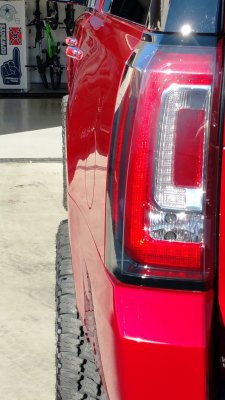I would say camber is set to far +. The outward or inward tilt of a wheel, called positive when the top tilts outward and negative when it tilts inward, measured as the angle, in degrees, between the vertical and a plane through the circumference of the tire. Basically, your front tires look like they are sticking out more on the top vs. the bottom. Kinda like a V. Most modern late model vehicles are set to 1-2 degrees negative camber or an up side down V...typically not visible to the naked eye.
I just had an alignment after my lift went on 1000 miles ago and my front tires appear out further on top (+camber) than bottom. I also have the feathering on the outer edge of the front tires. Some is normal as the front tires turn while the rears stay stationary. But what I've seen on mine is more than normal for 1000 miles...
I believe, since it was just aligned and tracks straight, it is still within oem spec. Many times the factory specs, regarding camber, caster and toe-in are exaggerated to help with over/under steer. They try and put it in the middle for your average driver to aid in their ability to control the vehicle in safe manner.
I'm not an alignment tech or expert by any means, just stating what I've learned and been told by others more experienced in this subject.
Here's a pic and it shows my front tire appearing to be +1 to 1.5 camber, or slightly out compared to rear.

Cheers,

